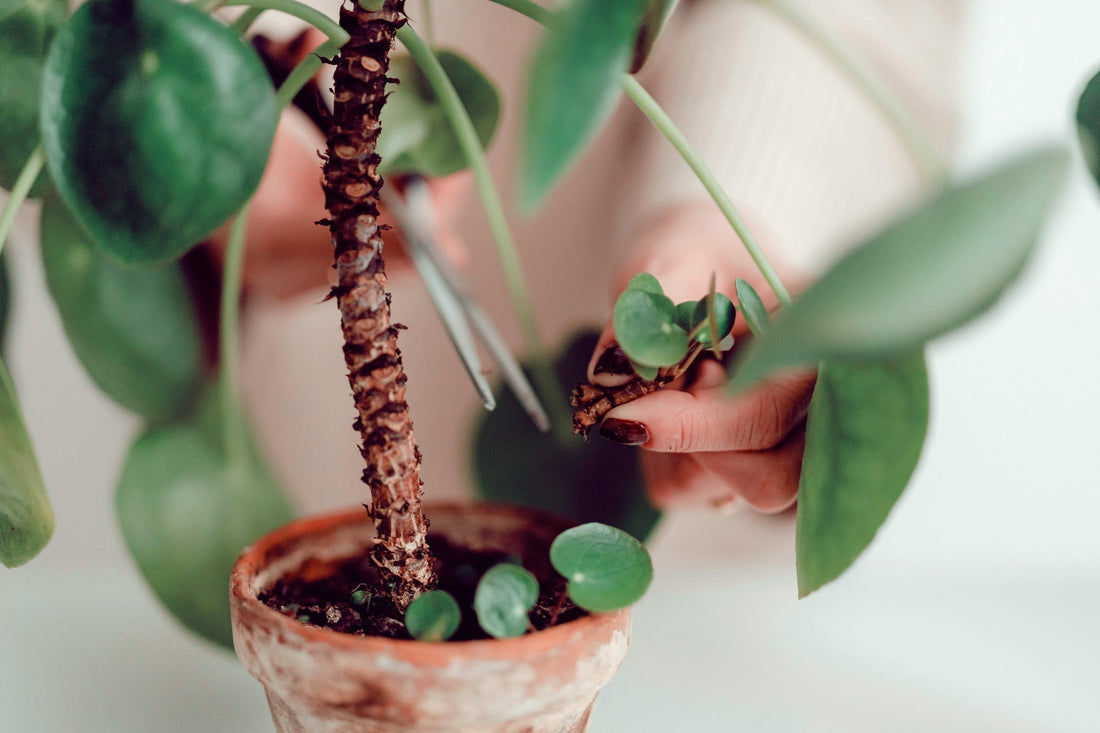
Quick‑fire formula: Bright, indirect light, water when the top 20% of soil dries, and feed monthly with Big Green Leaves®—your shortcut to lush, luck‑laden foliage.
Meet Your “Money Makers”
Money Tree (Pachira aquatica)
- Aliases: Malabar chestnut, feng‑shui lucky plant, braided money tree.
- Wealth lore: Braided trunks are believed to trap prosperity energy, while five‑leaf clusters symbolize the five elements—very chic, and luckily, easy to care for.

Chinese Money Plant (Pilea peperomioides)
- Aliases: Coin plant, pancake plant, UFO plant.
- Good‑karma tip: Gift propagated “pups” to friends—sharing is said to multiply luck for giver and receiver.

Light: Where Fortune Shines
- Money Tree: Bright, indirect light—an east‑ or west‑facing window is perfect.
- Chinese Money Plant: Medium‑bright, filtered light; avoid harsh afternoon sun.
- Quarter‑turn the pots weekly so every “coin” leaf soaks up its share of rays.
Watering Routine: Liquid Assets
- Money Tree: Water when the top 20% of soil dries—about every 7–10 days in active growth, 14–20 days in winter.
- Chinese Money Plant: Hold off on water until the entire planter is nearly dry. Depending on the reservoir size of your planter and soil medium, this could be every 7-14 days. Bottom‑watering keeps crowns dry and leaves spotless.
Feeding Their Fortune
Even “lucky” plants need minerals to print new leaves. Feed both monthly (spring–fall) with Big Green Leaves® Houseplant Food—a thoughtfully formulated blend of NPK, seaweed, and micronutrients that fuels vibrant growth without salt build‑up.
- Money Tree: 1-2 tsp per gallon of water
- Chinese Money Plant: 1-2 tsp per gallon of water

Feed both your Money Tree and Chinese Money Plant on the regular with Big Green Leaves® to fuel those lucky leaves and coins.
Pruning & Propagation: Shape Your Wealth
Money Tree
- Pinch new tips every 4–6 weeks for a fuller canopy (diagram below).
- Re‑braid flexible stems while they’re pencil‑thick.
- Remove dead or yellow leaves whenever they appear.
- To propagate, simply take a cutting from a stem that includes at least one node. Soak that node in a solution of water and Big Green Leaves® for quick root development.

Chinese Money Plant
- Minimal pruning required. This plant naturally sheds its oldest leaves.
- Snip only yellow or damaged leaves at the base with clean scissors.
- Harvest pups by slicing offsets and potting separately—that’s the main “trimming” you’ll do.
- If you want a taller, tree‑like look, remove a few lower leaves sparingly and provide bright overhead light—experienced growers report this helps form a bare stem without stressing the plant.
- Slice a pup with some roots from the mother plant and repot it into a small container to create a thoughtful plant gift in its own pot.
- Propagating this coin plant is easy, they will propagate in water or perlite from the stem or the leaf. Simply submerge part of this cutting in a solution of water and Big Green Leaves® for quick root development.

Snip a leaf shoot or full pup from the Pilea mother plant—these little coin plants were practically made for water propagation.

Spiritual Placement & Rituals
- Money Tree: Place near your home‑office entrance; tuck a jade coin charm in the pot to “lock in” abundance.
- Chinese Money Plant: Gift propagated pups in recycled jars with a handwritten gratitude note.
The Chinese Money Plant is famous for tossing out “pups” like spare change. When offsets reach 2–3 inches tall, slide a clean knife down the side of the mother stem to lift each pup with a bit of root attached. Pot the baby in a 3–4 inch nursery pot filled with a light, well‑draining mix, and water thoroughly.

Boost the take‑off: Add a pinch of Big Green Leaves® to your propagation water for the first month. The seaweed and micronutrients jump‑start root growth, letting your little “coins” establish faster and leaf out within a week or two.
Troubleshooting Quick‑Fire
- Crispy leaf edges? Humidity below 40 %. Add a pebble tray, cluster plants, or run a mini humidifier.
- Brown spots? Over‑watering or wet leaves in low light—adjust schedule and ensure drainage.
- Pale new growth? Time for that monthly Big Green Leaves® feed.
- Dull, dusty foliage? Spritz and gently wipe with Big Leaf Energy™ Neem & Essential Oil Spray for glossy, pest‑resistant leaves.
Top Money Plant Questions Answered
Money Tree FAQs
-
Why are my Money Tree leaves turning yellow or dropping?
Chronically wet soil, low winter light, or cold drafts are typical triggers. Let the top inch dry between waterings and keep temps above 60 °F. -
The trunk feels soft—am I over‑watering?
Yes. Softness signals rot. Unpot, trim mushy roots, repot in a fast‑draining mix, and water less frequently. -
My braided tree is drooping—should I water more?
Not until you check moisture. Droop can mean either drought or root stress from saturation. Feel the soil first. -
How do I make my Money Tree bushier?
Pinch the newest tips every 4–6 weeks and keep it in bright, indirect light; both actions trigger side branching. -
Does a Money Tree need high humidity?
Average indoor humidity is fine, but 40 %+ keeps leaf edges from crisping. Pebble trays or small humidifiers help.
Chinese Money Plant FAQs
-
Why are my Pilea leaves curling under?
Usually low light, inconsistent watering, or heat stress. Move to brighter indirect light and adopt a steady watering rhythm. -
My plant looks leggy—how do I fix it?
Give it brighter light, rotate weekly, and consider chopping & re‑rooting the top if stems are too stretched. -
Leaves are pale or yellowish but not crispy—what’s wrong?
Light is likely too weak. Move closer to a window or add a grow light. -
How often should I water a Pilea?
Let the top inch dry—roughly every 5–7 days in active growth. Bottom‑water to avoid crown rot. -
Why isn’t my Pilea producing pups?
It needs brighter light, a monthly dose of Big Green Leaves®, and room to grow. Healthy, well‑fed plants pup readily.
Ready to take your plants beyond basic? Feed them Big Green Leaves® and watch your fortune flourish—no Wall Street required.
And remember, what you feed grows.



